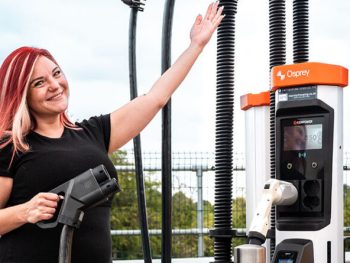I love driving an electric car, but charging it is a different story – here’s why
Rebecca Whittaker, head of diversity and inclusion at ALD Automotive | LeasePlan, and Kate Tyrell, co-founder of ChargeSafe, on why safe EV charging infrastructure is a need, not a want.

Rebecca Whittaker, head of diversity and inclusion at ALD Automotive | LeasePlan
Whether it’s a friend, neighbour or colleague, most of us know someone who drives an EV nowadays. At the time of writing this, there are approximately 920,000 fully electric vehicles on UK roads and a further 560,000 plug-in hybrids. This means that for every 36 vehicles, 1 is battery-powered.
Yet, very few EV drivers are women – around one in 10, according to a survey by Bonnet.
There are several reasons why this might be. One of them, I believe, is due to some women’s concern about safety when it comes to charging their vehicles. According to research from Keele University, female EV drivers are more likely to feel apprehensive about using chargers late at night or in poorly lit areas due to fear for their personal safety.
As a driver, stepping behind the wheel of an EV is an incredibly enjoyable experience. Vehicle manufacturers are investing huge amounts into their design, and subsequently, you find yourself in an environment that feels safer, more comfortable and more intuitive.
Sadly, this isn’t always the case when it comes to charging your vehicle. Depending on where you are and what time it is, you might find yourself feeling vulnerable, particularly if you’re by yourself. This won’t be the case for all female drivers. I have had nothing but good experiences, but one bad experience is too many.
So, what more can be done to ensure female EV drivers can always charge confidently and without fear?
Case study: Kate Tyrell, co-founder of ChargeSafe

Kate Tyrell, co-founder of ChargeSafe
Kate Tyrell, the co-founder of ChargeSafe, has been driving an EV since September 2020. Her company provides a simple rating system for public EV chargers, allowing drivers to check for safety and accessibility.
The idea for ChargeSafe was born out of an unfortunate experience which left her feeling unsafe as a woman charging her EV. Kate was driving a 300-mile round trip and found herself needing to charge her vehicle sooner than expected due to a combination of roadworks and diversions.
She eventually found a charging station, but it was in a dark and empty car park at the back of a leisure centre. She then proceeded to have trouble using the charge point as it required a downloaded app to register her personal details. Feeling nervous and worried about her safety, she decided to look for another charging station at a nearby supermarket. However, this charger was also located in a dimly lit area and would not charge her car due to technical faults.
For a third time, Kate drove to another charge point at a petrol station. Again, this location was poorly lit, with very little human activity and no workers in the petrol station. This left her feeling vulnerable and exposed to anyone passing by whilst she charged.
In the end, she decided to crawl along in limp mode on the motorway’s hard shoulder to reach a safe and well-lit charging point – just about making it within her remaining range.
Introducing minimum safety standards
Overall, the UK is doing a really good job with the roll-out of EV chargers (we’re currently ranked third in Europe for EV readiness, behind Norway and the Netherlands). Last month alone, over 1,600 new chargers were installed across the country.
The Government is also introducing new Public Charge Point Regulations to ensure a safer and more reliable EV charging experience. The regulations include an introduction of a 24/7 helpline and 99% reliability for fast chargers. This will apply to network operators across England, Scotland, Wales and Northern Ireland from the end of 2024.
But to ensure that everyone feels safe when charging their vehicle, every charge point needs to be highly visible. According to data from ChargeSafe, just 13% of public EV charging points have sufficient lighting, while only 23% are in places where there is CCTV.
This should serve as an immediate call to action for all charge point operators (CPOs). So many charge points have been installed over the past few years to meet the boom in demand but without proper thought around the safety and accessibility of women.
However, it’s not just CPOs who decide where a charge point will go. There’s also the landowner who rents the space, the distribution network operator (DNO) who installs any additional grid operations, and the local authority who grants planning permission in the first place.
For this reason, we need a more joined-up approach from all the involved parties and more stringent regulations around charge point installation. Currently, there are no minimum standards for personal safety, making some sites particularly unsafe for women. At the very least, this should start with making proper lighting mandatory with every new and existing charge point and fully monitored CCTV cameras.
Charge point maintenance and community-led updates
Proper charge point safety also requires running regular maintenance checks on the equipment to ensure drivers don’t arrive to find a faulty charger. Not only is this inconvenient and time-consuming, but it also puts the driver in a more vulnerable position, particularly late at night or if they’re alone.
Building more community-based platforms could help women to feel safer at EV charge points. These allow other drivers to flag any malfunctioning equipment (which can then be fixed by regular maintenance checks) and suggest which charge points are the safest and the ones to avoid. These types of communities are already growing on social media platforms, with Facebook groups such as Women Drive Electric UK already gaining over one thousand members.
CPOs should also look at how they can use charging apps to enhance driver safety. This could include safety features like automatic location sharing with selected contacts or an integrated panic button, which automatically connects drivers to emergency services – something we’re already seeing used on rideshare apps such as Uber.
Making EV charging safe for all

ChargeSafe says the Gridserve electric forecourt in Braintree, Essex, is a great example of a safe and accessible EV charging site
A smooth transition to zero-emission vehicles will only happen if we have widespread buy-in from every driver group. And to achieve this, we need to ensure we’re building an infrastructure network that prioritises the most vulnerable.
Therefore, government bodies, local authorities, CPOs and landowners must work together to create safe charging spaces throughout the country so that women feel supported in making the switch.
The Gridserve electric forecourt in Braintree, Essex, serves as a great example of a safe and accessible EV charging site. Supplied with luxury amenities, plentiful lighting and accessible charging points, this forecourt exemplifies the features needed to make electric driving safer and more inclusive.
Hopefully, as the market continues to mature over the next few years, spaces like this will become the norm.
ALD Automotive | LeasePlanChargeSafesafe EV charging infrastructure

